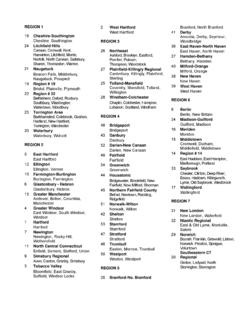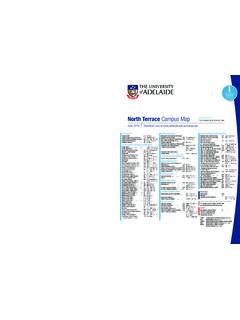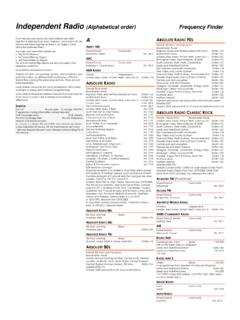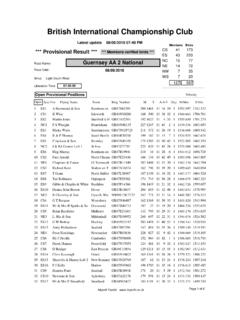Transcription of Cley, Wiveton & Blakeney Walk - Norwich Beer Festival
1 Norfolk Pub WalksCley, Wiveton & Blakeney WalkIntroductionForget the City and Market Town Walks! This is as rural as you can get. It is circular tour ofabout 4 miles in length, along lanes that link the three picturesque villages of - cley next the Sea, Wiveton and Blakeney . City and town dwellers who baulk at the idea of a country walk may choose to cycle or, if all else fails go by three villages lie close to the north Sea coast and next to one another. In medieval times the three villages (along with Salthouse, just over a mile to the east of cley ) made up a port, around the Glaven estuary known as Blakeney Haven . Today what was a medieval port are now fields. It takes some imagination to picture it asit was when the estuary stretched as far as Wiveton Church on the west bank, and to Newgate Green on the east bank and when at high tide sea going boats could moor up at quays on either side, at Wiveton Parish Church, and on the cley side near the presentHolt the 14thcentury, Blakeney Haven was important as a port for fishing and trade when wool and grain were exported in some quantity.
2 However, during the 17thcentury, the port declined as land enclosures caused the estuary to start to silt up, and gradually by the end of the century Blakeney Haven was no more. Land replaced water and cley and Wiveton became inland villages. Blakeney fared better and continued as a commercial port into the 18thand 19thcenturies, with imports of coal and exports of grain. In 1780 it is estimated that over 9,000 tons of coal were landed at Blakeney Harbour to supply Blakeney , cley and the local hinterland as far as Holt. Indeed quite large ships were still coming to Blakeney as late as the early the 20thcentury, Blakeney developed as a tourist resort and became particularly popular with yachtsmen, ramblers and birdwatchers.
3 Blakeney has great charm. The narrow streets are lined by well-maintained homes of great age. Old port buildings have been converted into flats. New hotels have been built. The vestige of a small quay has survived where holidaymakers board small boats and at high tide sail the meandering estuary to where the river enters the north Sea at Blakeney Point . Here there are numerous sandbanks and scores of MillGetting ThereThere is little in the way of public transport. The only regular service is the Coast Hopper which journeys from Sheringham to Hunstanton and passes along the main A149 north Norfolk Coast Road. The winter service (September to May) is two hourly. In summer (July to August) there is an hourly service.
4 The service has a bus stop at Blakeney at the western end of The Quay where it joins the main A149 road, and the other stop is in the main street in cley . At Blakeney there is a large car park at Blakeney Quay (National Trust). The George in cley has its own car park and parking is easy at The Three Swallows and Wiveton WalkThe walk starts in cley next the Sea, which is something of a misnomer as it is now about a mile from the sea. The most prominent and best-known landmark in the village is cley Millan 18thcentury windmill, situated to the north on the coast road to Salthouse, which was on the old deep water quayside up to the 17thcentury before the silting of the estuary started. It ceased working as a mill after the First World War but was then preserved.
5 Energetic visitors may climb to the top and view panoramic scenes of cley and the surrounding countryside and marshes. Cleyis also renowned internationally as a bird watching first pub is The George Hotel, situated on a sharp bend on the main A149 coast known as The George & Dragon , this old inn of Georgian origins changed hands in 2001 and afterextensive internal refurbishment was renamed the George Hotel . Only the small bar at the entrance is a pub and the rest of the public ground floor space is now given over to dining areas. There are en-suite rooms and self-catering accommodation. Opposite across the road is a large beer garden. Real ales sold here come from Woodforde s and Greene leaving The George Hotel turn left along the narrow street, through the pretty village centre of small houses with exteriors of flint with red brick dressings until you reach a bend.
6 Here the main road bends sharp right but your route continues straight on down Holt Road. After half a mile or so, you will reach Newgate Green and The Three Swallows, the second pub of the route. The Parish Church of St Margaret s is situated behind the the Parish Church behind and the Village Green in front and with scenic views overlooking the Glaven Valley and Wiveton Church, The Three Swallows is the country pub we have all imagined. It was previously owned by Steward & Patteson and Watneys but in 1998 became a freehouse. It has a very cosy interior with two bars, and a separate dining area. The low ceiling, small windows and old fireplaces convey an olde world feeling . The cask ale supplied here comes from Adnams and Greene King.
7 Food is available all day. There is also en-suite accommodation leaving The Three Swallows you may wish to visit the large and impressive St Margaret s Church, which dates back to the 14 century. Its size reflects the prosperity and size of the port at that time in history Whatever, when leaving, continue in the same direction as before down the Holt Road. (You may wish to take a short cut across the Green). A short distance will bring you to a crossroads whereyou turn right to Wiveton . Soon you will come to the 15thcentury humpbacked Wiveton Bridge where you cross the River Glaven. Continue up a short hill and you will reach Wiveton Green. St Mary s Parish Church on your right and The Bell, the next pub on the route, is across the far side of the green.
8 If you think it worthwhile, the St Mary s Wiveton Parish Church is worth a Wiveton Bell beside the Green has a large open planned bar with exposed beams and an inglenook fireplace. There is a large non-smoking conservatory at the back, which leads out to a beer garden that in summer months becomes an el-fresco dining area. Beers sold here are from Woodforde s and other guest ales usually from local breweries. The restaurant offers highly recommended cuisine presented by a Danish leaving The Bell, turn right and take the Blakeney Road that continues into the Wiveton Road and after about a mile you will arrive in the Parish of Blakeney . On your right stands the imposing Parish Church, ofSt Nicholas. Hopefully you are not tired of visiting churches, for this is a gem and much larger than the other churches.
9 It is unique in that it has two towers. The main tower is very tall with 137 steps to climb to the top, but worthwhile for the splendid panoramic views of Blakeney and nearby villages. The second smaller tower on the east side was where beacons were once lit to aid ship navigation and could be seen up to 20 miles out to sea. Today, a light is still lit each evening at past the Church is the junction with the A149 main coast road. Turn left and walk downhill to the crossroads by a bus shelter where you turn right into the old village of Blakeney . Some way along the charming and narrow street, usually cluttered by cars and tourists you will reach The Kings King s Arms is an attractive white washed flint Grade II listed building with a spacious interior of six separate bars.
10 Five cask beers are usually available from a variety of different breweries served by handpump and gravity. Accommodation is available including guest rooms and leaving The King s Arms turn left (note the ornate village sign) and down to Blakeney Harbour and The Blakeney Hotel, a large building that dominates the skyline of Blakeney Blakeney Hotel is the largest and grandest hotel in the village (AA 3 star rated) with over sixty en-suite rooms. Sir Henri Derterding who was at the time Chairman of The Shell Oil Company, built it in 1923 on the former site of a pub known as The Crown & Anchor best known to the locals as the Barking Dickey . There are numerous public rooms along with lounges including a bar that sells real ale.








